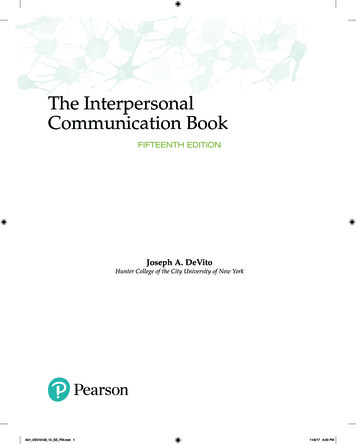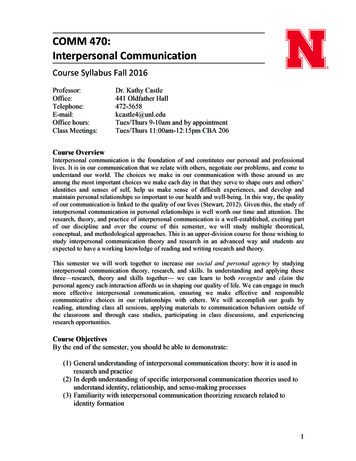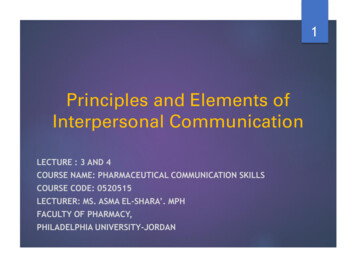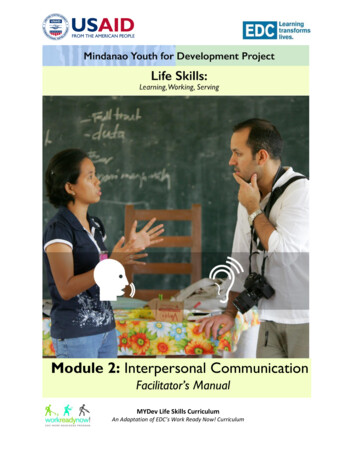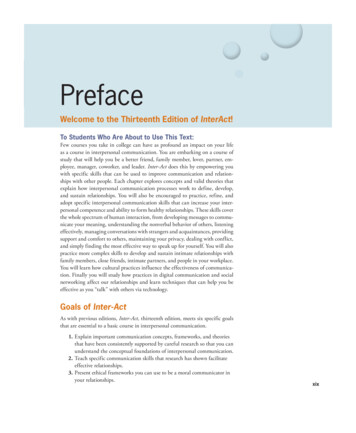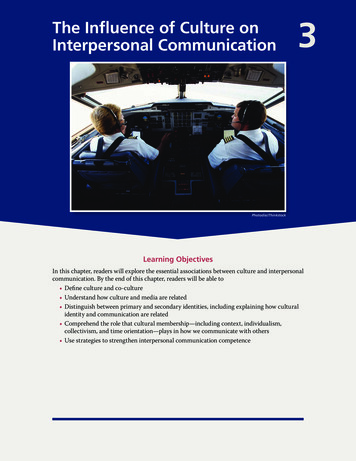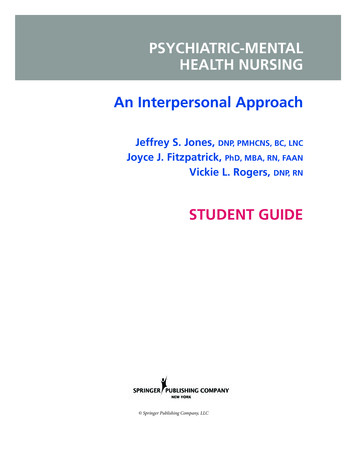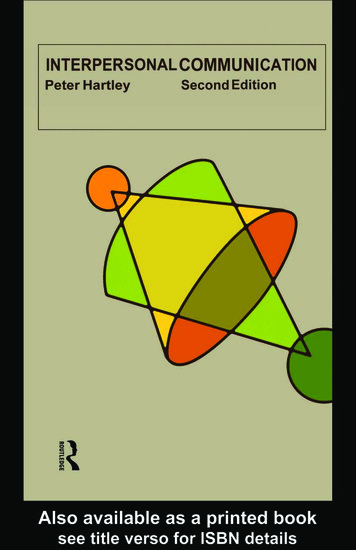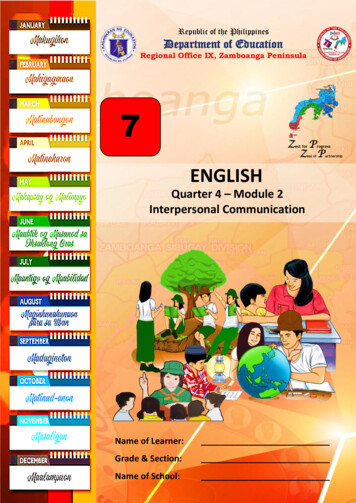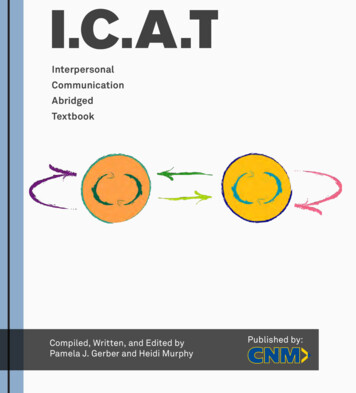
Transcription
ompiled, Written, and Edited byPamela J. Gerber and Heidi MurphyPublished by:
Chapter 1: Introduction to CommunicationAbout 70% of our days are spent communicating (Alberts, Martin, &Nakayama, 2016), either face-to-face or through mediated platforms, suchas email or text message. Yet, we often overestimate how well othersunderstand us and how well we understand others. The purpose of this text isto provide knowledge and skills to help minimize miscommunication ininteractions and increase communication competence. Even though we havebeen communicating our entire life, there are always ways to improve andtechniques we can learn to be more effective and accomplish our goals, in bothpersonal and professional contexts. In this chapter, we will begin our journeyinto communication by becoming familiar with the communication process,addressing contextual considerations, exploring the principles ofcommunication, and discussing communication competence.Essential QuestionsHow does the communication process work?What does it take to be a competent communicator? And why is itimportant in our lives?Successful students will be able to:define communicationrecognize components of the interpersonal communicationprocess
recognize how context can affect shared meaningexplain seven principles of interpersonal communicationexplain three interrelated types of interpersonal competenceidentify three ways to grow interpersonal competenceInterpersonal Communication Abridged Textbook (I.C.A.T.); Central New MexicoCommunity College; 2019; CC BY NC SA 4.0 except where noted below:Section 1.3.1: adapted from Communication in the Real World: An Introductionto Communication Studies; University of Minnesota; 2016; CC BY NC SA 4.0
myText CNM Customize 17 0 New Edit Lesson Howdy, Jacob Lujan Search My Profile My Books Catalog Glossary Cart Help Logout1.1.0: Communication: Definition and The CommunicationProcessIn this section, we will define communication and discuss the components ofthe communication process.1.1.1: Definition of CommunicationIn this text, we define communication as symbol using and meaning making.Communicators exchange two types of symbols, verbal and/or nonverbal, andattach meaning to said symbols. For example, the meaning attached to theverbal symbol “hello” is a greeting. You can also convey this greeting by using anonverbal symbol, such as a hand wave. However, it is important note that themeanings we attach to symbols can vary from person to person. For example,another communicator might instead interpret a hand wave as trying to gettheir attention.
1.1.2: The Communication ProcessIn order to better understand how verbal and nonverbal symbols are produced,interpreted, and coordinated in interactions, it is necessary to understand thecomponents of the communication process.Communicators:Senders and receivers of messages in a communicative interaction.Because we are continuously sending and receiving verbal and/ornonverbal messages, we are simultaneously both a sender and receiver ininteractions. For example, in a face-to-face interaction, the othercommunicator may be recounting an experience verbally with words andnonverbally with hand gestures, while we are sending our own nonverbalmessages via eye contact, facial expressions, posture, etc.Encoding:The process of turning our thoughts, ideas, and feelings into verbal and/ornonverbal messages.Decoding:The process of interpreting and adding meaning to the verbal and/ornonverbal messages we receive.Symbol:A thing that represents or stands for something else. In communication,symbols can be verbal, such as words, or nonverbal, such the ‘okay’ handsymbol.
Message:Verbal and nonverbal symbols that represent thoughts, feelings, and ideas.Messages can be both intentional (conscious) and unintentional(unconscious). For example, we may intentionally smile at a friend butunintentionally fidget with our hands when nervous.Channel:The means through which the message is sent from one communicator tothe other, such spoken words, a text message, or our hands to make agesture.Feedback:The verbal and nonverbal messages sent by one communicator in responseto the other communicator’s message(s). For example, if someone says aword we are unfamiliar with, we may frown in response or give them aconfused look to let them know we do not understand.Noise:Noise is a type of interference in the communication process that resultsfrom the physical, relational, individual, and/or cultural context. Noise canoccur in various places in the process, such as in the people, in the channel,in the message, and even outside the interaction.
(Image: The Communication Model. Pamela J. Gerber, CC BY NC SA 4.0)In any interpersonal interaction, there are at least two communicators and bothcommunicators are generating and creating meaning by simultaneouslysending and receiving messages. For example, in a face-to-face interaction, wemay be telling a story about our horrible day and the other person may belistening. While we are telling our story, we are encoding our thoughts andfeelings and considering which details to leave out and which ones to talkabout. Think about the last time you recapped your experience at a socialgathering for a friend and then again for a family member. Did you focus ondifferent details with each person? That’s encoding. While telling the story, wemay use both verbal and nonverbal symbols to create the content of our
message. The channel we send our message through can be spoken words (forverbal symbols) or hand gestures (for nonverbal symbols). The othercommunicator, who is listening, decodes the message by interpreting andadding meaning to it. In addition, the listener is also simultaneouslycommunicating messages back to us. This is called feedback. They may benonverbally establishing eye contact (or not), yawning, or verbally interruptingor asking questions. Chapter 1: Introduction to C 1.2.0: Shared Meaning and Back to: I.C.A.T Interpersonal Communication Abridged Textbook 2019 Central New Mexico Community CollegeAlbuquerque, NM (505) 224-3000Powered by Element LMS
1.2.0: Shared Meaning and ContextIn this section, we will discuss how we use communication to create sharedmeaning and how the meaning created is influenced by four types ofcontext: physical, relational, individual, and cultural.1.2.1: Shared Meaning(Image: Cathy Guisewite; reprinted with permission for use in I.C.A.T)Shared Meaning: While what we mean is usually very clear to us, others may decode/interpretour messages differently from what we intended resulting in a lack of shared meaning.In communicative interactions, the goal is usually to create shared meaning.
Shared meaning is achieved when the receiver attaches a similar meaning to themessage that the sender meant to convey. In other words, shared meaningoccurs when what was intended by one was similarly interpreted by the other,and/or what was interpreted by one was what was intended by the other. Forexample, let’s say we were at a bar and winked at someone to express interest inthem. If they likewise interpreted our wink as interest, then shared meaninghas been created. However, if they interpret our wink as an eye twitch, thenshared meaning has not occurred. As we know from our experiences, sharedmeaning is not always achieved in interactions or may require additionalclarification. That is because the various factors, or context, surrounding ourmessages can influence how those messages are produced, interpreted andcoordination. There are four main types of context to take into consideration ininterpersonal interactions- physical, relational, individual, and cultural- whichare discussed in the following subsections.1.2.2: Physical ContextThe physical context is the environment where the communication takes place,such as a bedroom, hallway, or bar. Within the environment, factors like thesize of the space, the temperature, and number of other people present willshape the communication that occurs (DeVito, 2014). For example, a noisy,crowded-bar might limit communication or create external noise that interfereswith your ability to hear the message. On the other hand, a quite coffee shopwith a fire might encourage communication. Physical space even operates inwhat we typically think of as virtual spaces, like social media. For example,Twitter limits the amount of characters in a tweet, thus messagescommunicated via this platform are often concise and abbreviated (DeVito,2014).
(Image: Brooke Cagle, Unsplash)Physical Context: The physical context is the environment where thecommunication takes place. Think about how a coffee shop or bar mightencourage communication, whereas a loud concert might prevent it.Also, think about the objects present in the physical environment. Do youthink technology, such as a phone or computer, could be a barrier ordistraction?1.2.3: Relational ContextThe relational context pertains to both the type of relationship that we havewith a person and our previous history of interactions with them.Communication norms and rules vary based on the type of relationship peoplehave, such as whether they are a friend, family member, supervisor, significantother, etc. For example, communication norms and rules that apply to asupervisor-supervisee relationship are different from a romantic relationship.In addition, we also share a communication history consisting of previousinteractions we have had with a particular person and this will influence themeaning behind messages. For example, let’s say we asked our partner to pickup milk on the way home from work. When they arrive home, we might say
“Did you get it?” While this might not make sense to another person viewingthe interaction, “it” is understood as “the milk” based on our previouscommunications (Verderber, MacGeorge, & Verderber, 2016).1.2.4: Individual ContextThe individual context refers to characteristics that are specifically related to us,such as our cognitive and physical abilities, personality, emotional state,internalized biases/prejudices, past experiences, and/or internal motivations.Individual characteristics are unique for every person and influence how wecommunicate with others (Alberts, Nakayama, & Martin, 2016) and weinterpret another communicator’s message. For example, if we are feelingstressed and angry from a long day at work (emotional state), we mightinterpret someone’s one-word replies as a form of intentional disrespect. Whenfeeling calm and rested, though, we might interpret these same types of repliesas a sign that they may be suffering from emotional upset.The Individual context can also create noise that interferes with the production,reception, and interpretation of a message. For example, physiologicalprocesses, such as stuttering, can interfere with message production. Hearingproblems may interfere with the reception of the message, as well as our mentalstate, such as being preoccupied or daydreaming. Individual conceptions of aword also create a type of semantic noise which will influence its interpretation.For example, while you innocently referred to your date’s spending habits as“frugal,” he was offended because he thought you meant he was “cheap.”1.2.5: Cultural Context“Culture refers to the learned patterns of perceptions, values, and behaviors
shared by a group of people” (Alberts, Nakayama, & Martin, 2016). Whileculture is often used to refer to large groups of people by country (U.S. Mexico,China, etc.), we also belong to many overlapping co-cultures based on facets ofour identity such as race, ethnicity, gender identity, sexual orientation,generation, religion, etc. Communication is embedded in culture and co-culturebecause they dictate rules and norms for behavior in interactions. For example,take a co-cultural category such as gender identity, and think about norms forhow females and males should (or should not) sit. Females will often try to takeup as little space as possible when sitting and will cross their legs, whereasmales will typically spread out- a phenomenon that has recently been dubbed‘manspreading.’). The reason why females sit one way and males another isbecause we learn norms and rules for behaviors, like sitting, walking, etc.Growing up, females are often explicitly told “cross your legs” and “don’t sitwith your legs open.”Often times, behaviors we think are normal are actually not innate, rather wehave learned them explicitly or implicitly via the culture and co-cultures webelong to. Culture and communication are inseparably intertwined as ourvarious co-cultural identities influence how we communicate and how otherscommunicate with us (Alberts, Nakayama, & Martin, 2016). Culture and coculture may also create semantic noise due to variations in a particular group’suse and understanding of a word or phrase. For example, take the word ‘cool’,one generation may use it in reference to temperature while another may use asa synonym for awesome. Co-cultures also attach experiences and emotions toparticular words that another group may not, such as derogatory terms.
1.3.0: Principles of CommunicationIn this section, we will be discussing how communication is used to meetneeds; exists on multiple levels; is a transactional process; is situated; canbe either face-to-face, mediated, or both; is continuous, intentional, andunintentional; and is irreversible.1.3.1: Communication Meets NeedsIn addition to using communication to exchange messages and create sharedmeaning, we also use it to meet the various needs we have as human beings.Communication meets four needs: physical, instrumental, relational, andidentity.Physical needs include needs that keep our bodies and minds functioning.Communication, which we most often associate with our brain, mouth, eyes,and ears, actually has many more connections to and effects on our physicalbody and well-being. At the most basic level, communication can alert othersthat our physical needs are not being met. Human beings are social creatures,which makes communication important for our survival.Instrumental needs include needs that help us ‘get things done’ in our day-today lives and achieve short- and long-term goals. We all work towards shortand long-term goals every day. Fulfilling these goals is an ongoingcommunicative task, which means we spend much of our time communicatingfor instrumental needs. Some common instrumental needs include influencingothers, getting information we need, or getting support (Burleson, Metts, &Kirch, 2000).
Communication meets our relational needs because it is throughcommunication that we begin, develop, maintain, and end relationships. Inorder to develop a relationship, we may use nonverbal communication to assesswhether someone is interested in talking to us or not, then use verbalcommunication to strike up a conversation. Then, through the mutual processof self-disclosure, a relationship forms over time. Once formed, we need tomaintain a relationship, so we use communication to express our continuedliking of someone. We can verbally say things like “You’re such a great friend.”Finally, communication or the lack of it helps us end relationships. We maycommunicate our deteriorating commitment to a relationship by avoidingcommunication with someone, verbally criticizing him or her, or explicitlyending a relationship. From checking in with relational partners by text, socialmedia, or face-to-face, to celebrating accomplishments, communication formsthe building blocks of our relationships.Identity needs include our need to present ourselves to others and be thought ofin particular ways. Our identity changes as we progress through life, butcommunication is the primary means of establishing our identity and fulfillingour identity needs. Communication allows us to present ourselves to others inparticular ways. Just as many companies, celebrities, and politicians create apublic image, we present different faces in different contexts. The influentialscholar Erving Goffman compared self-presentation to a performance andsuggested we all perform different roles in different contexts (Goffman, 1959).For example, you may perform the role of a parent when at home with yourchild, but the role of supervisor when at work.
(Image: Timothy Paul Smith, Unsplash)Communicating Identity: Communication allows us to express our identities, both verbally andnonverbally. Our physical appearance, such as clothing choices, grooming, accessories, andbody art, enables us to present an image of ourselves to others.1.3.2: Communication Exists on MultipleLevelsCommunication operates on two distinct levels: there is a content dimensionand a relational dimension. The content dimension is the meaning of the actualmessage itself, whereas the relational dimension expresses “how you feel aboutthe other person: whether you like or dislike the other person, feel in control orsubordinate, feel comfortable or anxious, and so on” (Adler, 2017, p. 18). Forexample, consider the difference between someone saying “I’m busy tonight” in
an annoyed tone versus “Sorry babe, I’m busy tonight” in an apologetic tone.Both messages mean the same thing on the content dimension, but expressdifferent feelings on the relational dimension. There may be times when thecontent dimension is all that matters; likewise, there are other times wheremore importance is placed on the relational dimension (Adler & Proctor,2017).1.3.3: Communication is TransactionalCommunication is also a transactional process, this means that: 1) Eachcommunicator is simultaneously a sender and receiver of messages. 2) Meaningis co-created in the interaction by both communicators. 3) Communication isan ongoing process and previous interactions between communicatorsinfluence current interactions. And since communication is ongoing, 4) currentinteractions likewise will influence future interactions and will either affirm ormodify perceptions of the other and the relationship (Alberts, Nakayama, &Martin, 2016).1.3.4: Communication can be Face-to-Face,Mediated, or BothCommunicative interactions can take place face-to-face using verbal symbols,such as words, and nonverbal symbols, such as gestures. They can also takeplace through a mediated platform, such as a smoke signal, email, or textmessage. Sometimes, it can even be a combination of face-to-face andmediated, such as when a speaker is presenting to an audience with amicrophone. How the interaction takes place will affect how messages areproduced, interpreted, and coordinated.
(Image: Khalid Albaih,CC BY 2.0)Communication Channel: Our communicative interactions can takeplace face-to-face and through mediated-platforms, such as textmessage or social media. The channel we use to communicate isimportant as there are nuances that coincide with each whichinfluence meaning.1.3.5: Communication is SituatedAll communication is situated, which means that communication occurs withina specific setting “that affects how the messages are produced, interpreted, andcoordinated” (Verderber, MacGeorge, & Verderber, 2016, p. 16). Not only dothe contextual factors mentioned in Section 2 influence communication, butcommunication is also situated historically, economically, socially, andpolitically. For example, some current political rhetoric surrounding Mexicanimmigrants paints them as criminals and rapists; this can affect how others
perceive and communicate (or avoid communicating) with people that fall intothis group.1.3.6: Communication is Continuous,Intentional, & UnintentionalIn all communicative interactions, we are continuously sending messages,whether they are verbal or nonverbal, and whether it is intentional (conscious),or unintentional (unconscious). Although communication may seem like aperceptible and deliberate process, we often send messages without consciousthought. In fact, there are so many messages being sent at one time that manyof them may not even be received.Additionally, not all behavior is consciously encoded. For example, we mighthave had a rough night with little sleep, which us yawn more often than wenormally would. We are not deliberately and consciously encoding the yawn,rather our body does it without forethought. However, our yawn mayunintentionally communicate “boredom” to the other person in the interaction.In contrast, a we may consciously decide to communicate a particular message(encoding) to another person if their story has gone on a very long time and wehave somewhere else to go. We may decide in our heads that we need a way outof the conversation and consider a yawn and a glance toward the door to be aneffective way to hint that we have to leave.
Mediated-Communication: In mediated communication interactions,such as those that take place through text message, we are stillsimultaneously senders and receivers of messages- even when we don’trespond to a message. Through this channel, a lack of response still canbe interpreted a variety of ways by the other communicator. They maythink we are busy or intentionally ignoring their texts.1.3.7: Communication is IrreversibleOnce something is communicated, it is irreversible and cannot be uncommunicated. While we “may try to qualify, negate, or somehow reduce theeffects once it has been sent and received, the message itself cannot bereversed” (DeVito, 2014, p. 25). Have you ever put your foot in your mouth andsaid something you wish you could take back? You may have even quickly said“I take it back,” but the impression created in the mind of the other cannot beerased. While we can apologize, there can still be consequences of the originalmessage. This principle is also important to note in mediated-communicationthat takes place through platforms such as email or a text message, as yourinteractions can also be saved and shared with others.
(Image: Derick Anies, Unsplash)Communication is Irreversible: The principle communication isirreversible reminds us that there are no ‘take backs’ when it comes towhat we say and do. This is important to keep in mind whencommunicating through technology, such as phones, as what we saycan be saved and easily shared with others.
1.4.0: Communication CompetenceAs stated in the introduction, the purpose of this text is to increasecommunication competence. Although the word ‘competent’ is somewhatsubjective and the definition can vary from person to person, we conceptualizecommunication competence as being comprised of three interrelatedcomponents. In order to be a competent communicator, our communicationneeds to be effective, contextual, and reflective. In this section, we discuss eachone of these components and how we can improve communication competence.1.4.1: Efective CommunicationEffective communication pertains to two things: achieving our goals andcreating (or not creating) shared meaning in interactions. As communicators,we have a variety of goals in interactions, ranging from trivial to important.Goals may include things like passing time, entertainment, getting or givinginformation, persuading another person, etc. (Verderber, MacGeorge, &Verderber, 2016). Usually, it can be pretty easy to measure whether or not wehave effectively achieved our goal(s). For example, let’s say our goal is topersuade our roommate to do the dishes. If they do the dishes, then we haveachieved our goal. If they do not do the dishes, then we have not achieved ourgoal.Effective communication also includes creating shared meaning in interactionsby encoding our messages in a way that will enable them to be easilyunderstood by the other communicator. For example, we may use concretephrases such as “the blue book on the counter” versus “that thing over there.”Although, sometimes we may purposely choose to use messages that are
ambiguous. For example, if a friend were to ask us, “What do you think of thisdress?” we may respond by saying “interesting” to avoid giving a direct answer.Because we are not always conscious of encoding and decoding, and becauseothers can decode both our intentional and unintentional messages in a varietyof ways (which we may not mean), in this text we will draw more attention toour cognitive processes in the interest of improving shared meaning andcommunication effectiveness.1.4.2: Contextual CommunicationContext and communication are inseparably intertwined. In order for ourcommunication to be effective, it must take context into consideration. Aspreviously mentioned, context plays an important role in how messages areproduced, interpreted, and coordinated. Different contexts have differentnorms and rules for what is considered acceptable (or unacceptable) andappropriate (or inappropriate) behavior. In other words, norms and rules existsfor what we should or can do, and what we shouldn’t or can’t do. A bar (physicalcontext) has different norms and rules for communication than a classroom.The norms and rules for interacting with a stranger versus a close friend(relational context) are vastly different. Contexts overlap, so the norms andrules are dynamic, constantly shifting, and may be hard for us to discern attimes. For example, it may be acceptable to kiss someone we are romanticallyinvolved with, but not a stranger (relational context). It may be acceptable tokiss we are dating at the park, but not in the workplace (physical context). Anddepending on our (co)culture (cultural context), it may not be consideredacceptable to be affectionate with someone we are dating in any public place.Because communication contexts are intertwined, it is important for us to beaware of the ways contextual nuances influence and shape interactions.In addition, contexts are also embedded with ethics, or what is considered rightor wrong in terms of actions and behaviors. Ethics exists on individual, cocultural, and cultural levels. For example, we may be part of a religion (co-
culture) that considers lying, regardless of the context, to be wrong. However,as an individual we may think it is okay to lie in certain situations, such as forsafety reasons or to protect our privacy. As competent communicators, we mustbecome adept at identifying contextual nuances and adapting our behavior tothe context. We will cover the specifics of contextual influences throughout thebook. Adding this knowledge to your understanding of interpersonalcommunication will help you make mindful choices that work for you and yourrelationships.1.4.3: Reflective CommunicationThe final component of a communication competence is reflectivecommunication, which means becoming more consciously aware and mindful.Being reflective means actively considering our own communication andanalyzing the long and short-term effects of our behavior(s) on our identity,other people, and our relationships.Identity:Since communication meets identity needs, both verbal and nonverbalcommunication is used to manage our identity and present an image ofourselves based on how we want others to perceive us. Identity is contextualand fluid and can be communicated intentionally and unintentionally. Forexample, let’s say in a professional context we want others to perceive us asbeing confident and intelligent. We might intentionally communicate thisnonverbally by looking at people in the eye and verbally by using big words.However, we may also unintentionally engage in behaviors that communicate adifferent identity to others than the one we what. For example, a briefinteraction in the workplace in which we yell angrily at a colleague may causethose who witness this interaction to perceive us as being immature or difficultto work with. Because of this, it is important to analyze how even smallinteractions contribute to other’s perceptions of who they think we are.
Others:Since interpersonal communication involves at least two people, the way wecommunicate impacts those around us, whether it be a stranger, friend, orpartner. Even a brief encounter with store clerk could have the potential toimpact that person positively or negatively. For example, if we were to give agrocery cashier a compliment by saying that we like their haircut, that mightmake them feel good. Likewise, if we were to insult them by saying their haircutis unflattering, it could have the opposite effect. While some may argue thatpeople are ultimately accountable for their own feelings and should takeresponsibility for them, competent communicators engage in perspectivetaking and are cognizant of the potential interpretations of messages and theeffects of these messages on others.Relationships:Finally, the way we communicate can have both short-term and long-termseffects on our relationships, both personal and professional. Getting into asuperficial argument in an intimate relationship may have the short-term effectthat other person not talking to us for the rest of the day. However, if in thatargument we said something extremely hurtful, even if we apologized later, thatother person may never forget what we said, and it may come up over and overagain and cause long-term issues in the relationship. In relationships, ourimmediate communication and how we communicate with others over periodsof time can be key to building healthy and mutually satisfactory relationships orunhealthy relationships that eventually dissolve.1.4.4: Improving CommunicationCompetenceThree key things can help improve communication competence: knowledge,
skills, and motivation.Knowledge:We can improve our communication competence by learning communicationconcepts, principles, characteristics, and theories. This knowledge enables us tobetter understand ourselves and others. Specifically, knowledge ofcommunication processes helps us develop self-awareness of our goals andabilities; investigate the whys behind the choices we make and the way weinteract with others, consider how our experiences and ex
explain three interrelated types of interpersonal competence identify three ways to grow interpersonal competence Interpersonal Communication Abridged Textbook (I.C.A.T.); Central New Mexico Community College; 2019; CC BY NC SA 4.0 except where noted below: Section 1.3.1: adapted from Communication in the Real World: An Introduction
